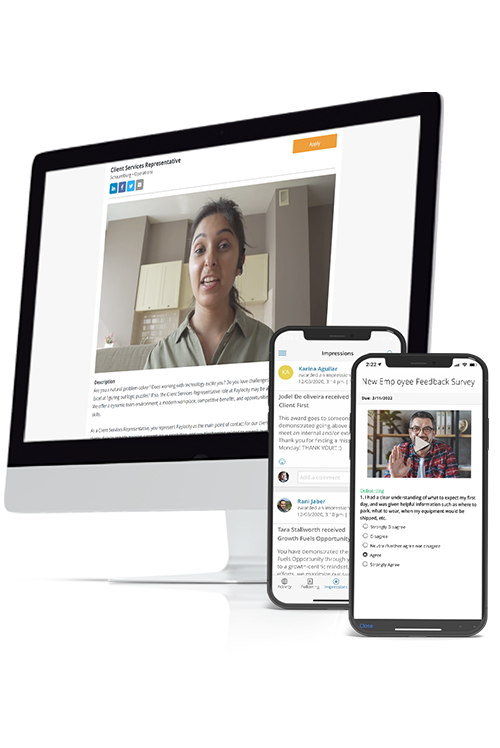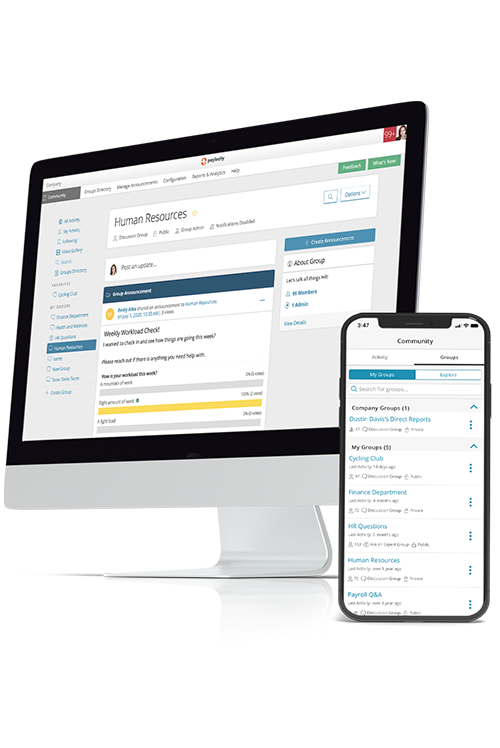Related Learning

Understanding the Link Between Employee Engagement and Retention
Learn the top employee engagement and retention strategies to make employees feel seen, supported, and uplifted — and actually eager to go to work.
When it comes to keeping employees around, engagement is your fuel — yet many workplaces are running on empty.
A recent Paylocity retention factors study identified employee engagement as the top indicator of employee retention. Meaning that the more engaged an employee is, the more likely they are to stay at their job.
Of course, that also means the inverse is true: The less engaged an employee feels at work, the less likely they are to stay — and that lack of engagement is common.
According to Gallup, only 34% of U.S. full and part-time employees report feeling engaged — on the contrary, they feel more detached from their work and less satisfied than ever.
Why does that matter? In 2024, employee turnover cost organizations across the U.S. $900 billion in replacement costs. On the flipside, companies with highly engaged workforces were 23% more profitable.
In this article, we’ll explain the link between employee engagement and retention, the methodology behind Paylocity’s engagement calculations, and how your organization can create an employee experience that improves job satisfaction and reduces turnover rates for good.
Key Takeaways
- Employee engagement and retention can dictate an organization’s success. Engaged employees feel a sense of satisfaction, commitment, alignment, appreciation, and belonging, encouraging them to stay put.
- Employee engagement and retention strategies should focus on making employees feel seen, accepted, and encouraged in their roles.
- With the right tools, HR teams can measure and improve employee engagement and even identify disengaged employees before they leave.
How Does Engagement Increase Retention?
Employees have specific wants, needs, and desires that extend beyond the basics of survival. Though this seems basic, organizations with competing priorities tend to overlook it.
To better understand this, let’s look at this from the perspective of Maslow’s Hierarchy of Needs. Most employers offer almost everything at the bottom of the pyramid and provide employees with the core necessities (a physically safe place, a paycheck, etc.). But they stop there.
Employers struggle to meaningfully move up the pyramid, particularly around “esteem, love, and belonging.” They often are strained to provide employees with a deeper sense of commitment, satisfaction, and care, which are the building blocks of true engagement.
But moving up the pyramid and providing these things is exactly what will encourage employees to stay.
When employees are appropriately engaged, they feel a sense of:
- Satisfaction: Engaged employees find their work fulfilling and enjoyable. According to Paylocity’s research, for example, employees who strongly agreed with the statement, “My work is challenging, stimulating, and rewarding,” had a rate of retention of 73%.
- Commitment: Engaged employees feel a sense of loyalty and responsibility toward the organization’s success.
- Alignment: Engaged employees’ personal values and goals align with those of the organization, making them feel that their work is meaningful and impactful.
- Appreciation: Engaged employees feel valued and acknowledged for their contributions.
- Belonging: Engaged employees feel fully accepted at their core, seeing themselves represented in ways that go beyond traditional diversity, equity, inclusion, and accessibility (DEIA) efforts.
How Paylocity Measures Engagement and its Connection to Retention
Paylocity’s Employee Voice platform is built to solve the longstanding challenge of measuring employee engagement— and we’ve used it to turn those insights into better retention outcomes.
Employee Voice removes the guesswork by leveraging a statistically validated engagement model built by Paylocity’s seasoned organizational development experts and data scientists. Through rigorous analysis, we’ve identified the most impactful survey questions to accurately measure engagement and improve retention.
Calculating Engagement Levels
At the heart of our model is the engagement score, which provides a fast, reliable snapshot of how engaged employees are.
The engagement score is based on averaging responses to statements related to dimensions of engagement. These questions assess how an employee feels about their workplace (e.g., “I believe in my company’s values”), and are highly correlated with retention.
Formula for Engagement Score
We calculate engagement based on the average favorability scores for the following statements, which collectively have a strong correlation with retention:
- I am happy working at my company.
- I believe in my company’s values.
- I would recommend my company as a great place to work.
Beyond this headline metric, Employee Voice also measures nine key drivers related to engagement. These are specific, actionable elements of the employee experience — ranging from manager support to work-life balance — that influence how employees feel and perform. Each driver is assessed through validated survey items to ensure reliability and relevance.
The Data Behind Engagement and Retention
Paylocity’s data science team analyzed extensive aggregated and anonymized datasets based on employee survey responses and real-world retention outcomes (like turnover and retention rates). All insights are drawn from aggregated platform data, with no identifiable or customer-specific information used at any point.
The Impact of Engagement
Based on our analysis, we uncovered that just a five-point increase in engagement score is associated with, on average, a 1.6 point increase in retention rate.
For a company with 1,000 employees and a 20% annual turnover rate, improving engagement by just five points would be associated with 16 fewer employees leaving each year.
So, what’s the business impact? Replacement costs typically range from 50% to 200% of an employee’s annual salary. With an average salary of $66,000, this translates into annual savings between $528,000 to $2,112,000.
Employee engagement directly impacts both retention and your bottom line. Even modest improvements can drive significant financial benefits through reduced turnover and the associated costs.
How to Improve Retention Through Engagement Initiatives
What’s next? Make sure you have the right employee engagement strategies in place that make employees feel seen, accepted, and uplifted (and, ultimately, more likely to stick around).
Uplift Employees
Employee engagement and turnover are predicated on how valued an employee feels, too. While lots of organizations think happy hours and custom swag do the trick, employees want — and deserve — much more.
- Create custom career and learning paths: Lack of advancement opportunities is one of the top reasons employees leave their jobs. Help employees feel committed and engaged at work by creating individual career trajectories that account for their specific skills and goals. And use a learning management system (LMS) to simplify and create engaging development opportunities for every employee, whether in-office or remote.
- Set expectations: A Gallup poll showed that only 45% of employees know what is expected of them at work. Remove confusion and improve engagement by establishing SMART goals (specific, measurable, achievable, relevant, and time-bound) that are tailored to their specific roles and objectives.
- Recognize and reward: Companies with good employee recognition strategies are 48% more likely to have high employee engagement rates. Use software that offers customized employee recognition programs, manages rewards and budgets, and tracks program metrics in real time.

See Employees
Employees are people outside of your office — they’re people with busy lives and competing priorities. To engage them, it’s crucial that employers not only recognize this but do something to support them.
Establish work-life balance
A whopping 82% of employees say they would be more loyal to their employer if they had more flexible work options. One reason is that flexibility gives employees autonomy.
Consider making it easier for employees to choose (or swap) shifts, and ensure PTO requests are streamlined and hassle-free. You could even enforce a strict no-contact policy after certain hours (like 5 p.m.) so your staff doesn’t join the 55% of employees who respond to work messages outside of normal hours.

Do away with multitasking
As technology advances, cultivating a true connection between employees and their work becomes harder, says Woodrie Burich, CEO and founder of The Integration Group, in an episode of Paylocity’s HR Mixtape podcast.
“Multitasking not only impacts [employees] cognitively, but emotionally too. It exhausts us,” he said.
To avoid multitasking burnout, encourage employees to set “deep work hours” where they aren’t responsible for answering emails or other messages and can focus on one task at a time. Provide templates or tools (such as calendar apps) that support time-blocking and focused work sessions.
Create time for inner connection
In the podcast, Woodrie also suggests that HR leaders create quiet spaces, even if this might seem counterintuitive.
“Quiet time allows us to think strategically and creatively and foster that inner connection that we have with ourselves in order to connect with others,” he said.
Allot time for employees to become unplugged, even for 30 minutes a day — and separate it from a lunch hour. Or create designated quiet spaces within the workplace, provide access to meditation apps or online resources, and establish a policy that encourages taking short breaks every couple of hours to recharge.
Accept Employees
Plenty of organizations have DEIA efforts in place, but many programs are only “box-checking” initiatives. Employees still feel unseen or unaccepted.
Going beyond traditional DEIA means creating a culture in which differences are critical to the success of the organization.
“HR leaders should really lean into cultivating organizations that have a bias for and not against difference,” said CEO of DC Global Group Dee Kendrix in an HR Mixtape podcast.
To create this bias for difference, HR should encourage change at several different levels throughout the organization:
- Organization-wide: Create a cross-organizational culture for bias with “spotlight” sections in company communications to highlight diverse, individual achievements. Plus, organize cultural appreciation days where employees can share their heritage, traditions, and histories.
- Manager to direct report: Pew Research shows that 84% of workers who regularly get feedback from their manager say they are extremely or very satisfied. Empower the leaders in your organization to really get to know their teams by encouraging recurring, personalized one-on-ones that are both structured and flexible. This will allow direct reports to both prepare and have the open opportunity to express concerns, questions, etc.
- Employee to employee: Socialization among employees leads to better work performance and engagement. To foster this connection and build community, use an employee communication hub designed for employees to connect with each other in real time through video and messages.

Engage and Retain with Paylocity
While all these strategies are great for boosting engagement and retention, organizations need to understand which employees are disengaged and why — and whether or not their new engagement efforts are working.
Paylocity’s Employee Voice survey tool helps organizations identify disengaged employees before they leave in three simple steps:
- Audit: Create and send automatic and scalable pulse surveys across your organization based on key employee journey milestones.
- Analyze: Use robust dashboards and heatmaps to better understand feedback and filter for deeper insights.
- Act: Generate meaningful insights through Paylocity’s customizable action plans and track them directly within the platform.
Want to learn more? Request a demo of Paylocity today!




